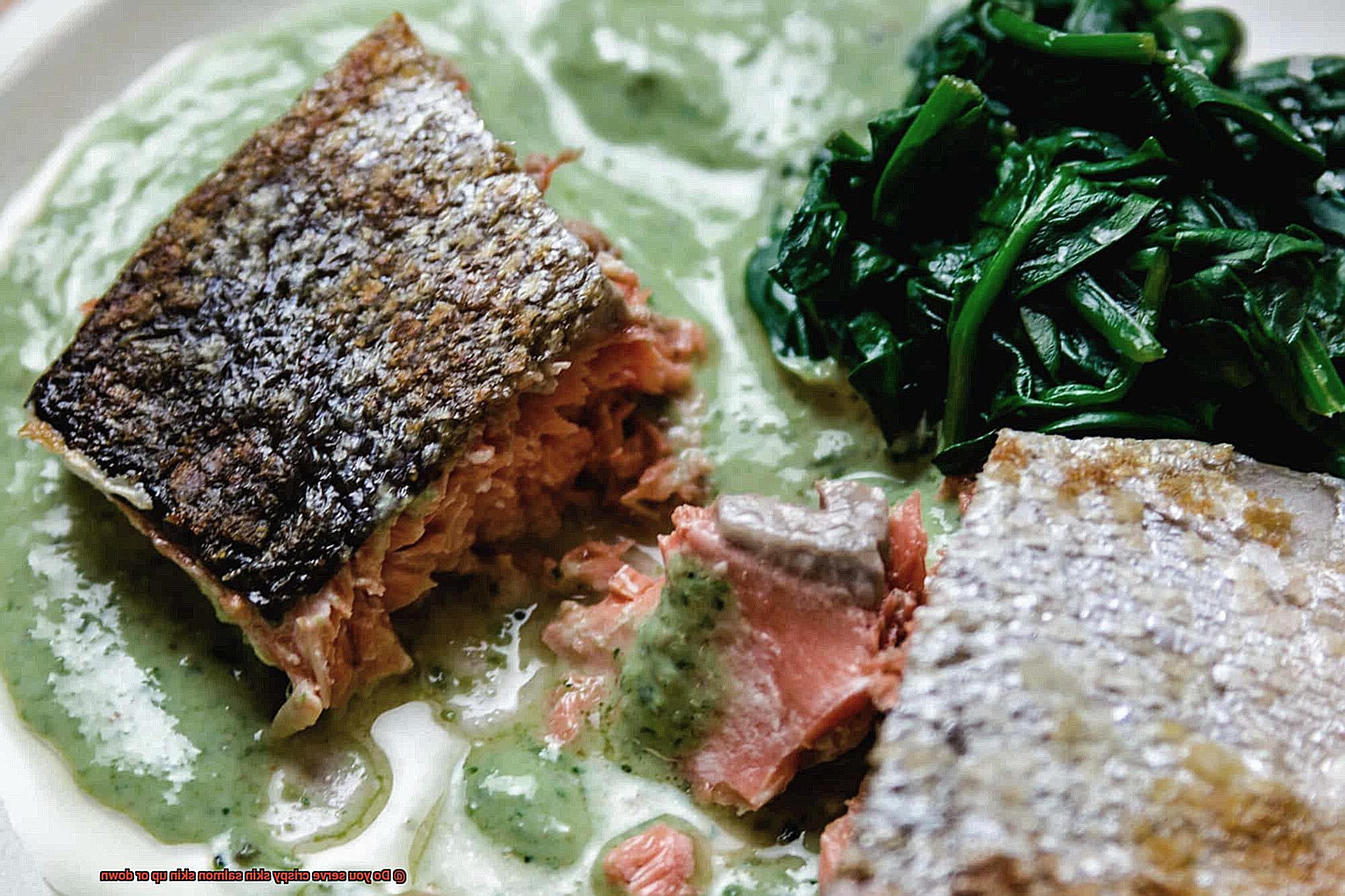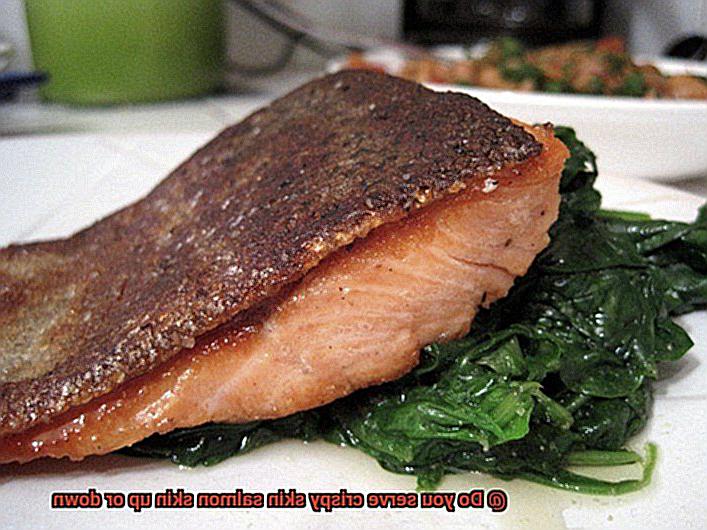Its delicate flesh and rich flavor make it a seafood lover’s dream. But let’s talk about something that has caused quite the kitchen controversy: crispy skin salmon – should we serve it skin up or down?
It’s a battle of preserving that delightful crunch versus ensuring even cooking. As the pan sizzles and mouthwatering aromas fill the air, this decision becomes crucial.
So, put on your aprons and join us on this culinary adventure as we uncover the truth behind this age-old uncertainty.
Contents
What is Crispy Skin Salmon?
Prepare to wow your guests at your next backyard barbecue with the mouthwatering and visually stunning dish known as crispy skin salmon. In this article, we will delve into the art of grilling this delectable masterpiece, from selecting the finest fillet to achieving the perfect combination of crispy skin and tender flesh.
Choosing the Right Salmon:
The first step to creating crispy skin salmon perfection is selecting a fresh and high-quality piece of fish. Look for firm and vibrant fillets with shiny, intact skin. Avoid any signs of discoloration or a fishy odor, as these indicate poor quality.
Preparing the Skin:
To ensure an impeccable outcome, it is essential to clean and scale the skin thoroughly. Removing the scales prevents a rubbery texture that could detract from the dish’s overall appeal. Patting the skin dry with a paper towel is another critical step, eliminating excess moisture and promoting effective crisping.
While salt and pepper are commonly used for seasoning, feel free to experiment with additional herbs and spices to suit your taste.
Grilling Techniques:
Pan-searing is the most popular method for achieving crispy skin salmon. Begin by heating a skillet over medium-high heat and adding a small amount of oil or butter. Once hot, place the salmon fillet skin-side down in the pan, gently pressing to ensure even contact with the heat. Cook for approximately 70-80% of the total cooking time on the skin side, allowing it to transform into a golden brown delight.
Alternatively, grilling, baking, and broiling can also yield exceptional results. The key is to ensure that the heat source is intense enough to crisp up the skin while simultaneously cooking the fish to perfection.
The Great Debate: Skin Side Up or Down?
Serving the salmon skin side up can be visually appealing, particularly when the skin is well-browned and crispy. It allows diners to appreciate the tantalizing texture before indulging in a bite. However, keep in mind that this method may cause the skin to lose its crispiness faster due to exposure to air and moisture.
On the other hand, serving the salmon skin side down can help maintain its crispiness for longer periods. Placing it on a serving dish or plate protects it from direct contact, preventing sogginess and preserving its delightful crunch. Experiment with both methods to determine which best suits your taste and that of your guests.
Pros and Cons of Serving Salmon Skin Up
Grilling salmon is an art form that demands precision and technique. One crucial decision to make is whether to serve the salmon with the skin up or down. In this article, we will explore the pros and cons of serving salmon skin up, allowing you to make an informed decision for your next grilling adventure.
Pros:
Enhanced flavor and protection:
- The fat from the skin renders and infuses the fish with a rich, savory taste.
- The crispy texture of the skin adds a delightful crunch, creating a perfect harmony of flavors and textures.
- The intact skin acts as a natural barrier, protecting the delicate flesh from direct heat, preventing overcooking and ensuring moist and tender salmon.
Presentation and texture contrast:
- The golden-brown, crispy skin adds an elegant touch to your dish, making it visually enticing.
- The contrast between the crispy skin and tender flesh creates a delightful textural experience.
- Each bite offers a satisfying crunch that complements the succulent salmon, elevating your dining experience.
Cons:
Difficulty in achieving crispy skin:
- Factors such as heat control, cooking time, and moisture content can affect how well the skin crisps up.
- Careful monitoring is required to prevent overcooking or undercooking that may affect desired texture.
Risk of sticking:
- Inadequate preparation or greasing may cause the skin to stick to cooking surfaces, making flipping or removing the fish challenging without tearing the skin.
Preference for no-skin option:
- Some individuals may prefer not to eat salmon skin due to taste preferences or concerns about pollutants and contaminants that tend to accumulate in the skin.
Pros and Cons of Serving Salmon Skin Down
Grilling salmon is an art form, and one of the key decisions you’ll need to make is whether to serve it skin down or skin up. This seemingly small detail can have a significant impact on the final result. Let’s dive into the pros and cons of serving salmon skin down and see if we can uncover the secret to the perfect grilled salmon.
First and foremost, serving salmon skin down offers several advantages. One major benefit is that it helps protect the delicate flesh of the fish from direct heat. By creating a barrier between the flesh and the grill grates, the skin prevents overcooking and ensures that your salmon cooks evenly. This means you’ll have a perfectly moist and tender piece of fish every time.
Another advantage of serving salmon skin down is the opportunity to achieve a wonderfully crispy skin. When exposed to direct heat, the skin has a chance to develop a delicious golden-brown crust that adds an incredible texture and flavor to your dish. It’s like getting two different experiences in one bite – the melt-in-your-mouth flesh and the satisfying crunch of crispy skin. It’s a match made in grilling heaven.
Additionally, serving salmon skin down makes it easier to remove the skin after cooking. Once your fish is perfectly grilled, the skin tends to stick to the grill grates. But fear not. By sliding a spatula between the skin and the flesh, you can easily separate them without any hassle. No more struggling with peeling off the skin before grilling – it’s a win-win situation.

However, there are some potential downsides to serving salmon skin down that are worth considering. One concern is that when the skin comes into contact with direct heat, it releases fat that can cause flare-ups on the grill. These flare-ups can lead to charring or burning if you’re not careful. So it’s important to keep an eye on your grill and adjust the heat as needed to prevent any mishaps.
Another thing to keep in mind is that serving salmon skin down may result in less flavor infusion from marinades or seasonings. Some chefs prefer to apply their marinades or seasonings directly to the flesh rather than on the skin. By serving skin side down, those flavors may not penetrate as deeply into the fish. However, you can mitigate this by lightly scoring the skin before marinating, allowing some of those delicious flavors to seep through.
Lastly, serving salmon skin down may not provide the most visually appealing presentation. The fully cooked skin can appear darker and less appetizing compared to the golden-brown crispy skin achieved when served skin side up. So if you’re all about aesthetics, this might be something to consider.
Factors to Consider When Deciding How to Serve Crispy Skin Salmon
Grilling salmon is an art form, and serving it with crispy skin is the ultimate masterpiece. But how do you decide whether to serve it skin up or skin down? In this blog post, we will explore the various factors to consider when making this crucial decision. From texture and presentation to moisture retention and flavor infusion, we will guide you through the process of serving crispy skin salmon like a pro.
Texture and Crispiness:
The texture and crispiness of the salmon skin are key considerations. Serving the salmon with the crispy skin facing up allows it to remain crunchy for longer, as it avoids contact with the plate, sauces, or toppings. The golden-brown color and delightful crunch add an extra dimension of enjoyment to each bite.
Presentation and Visual Appeal:
If visual appeal matters to you, serving crispy skin salmon with the skin facing up is the way to go. This presentation showcases the beautiful golden-brown color and texture of the skin, creating an aesthetically pleasing dish that will impress your guests or restaurant patrons.
Moisture Retention:
On the other hand, serving crispy skin salmon with the skin facing down can help retain moisture in the fish. The skin acts as a barrier, preventing natural juices from seeping out and keeping the flesh moist and succulent. This is especially important if you prefer your salmon cooked to a medium or medium-well doneness, as it helps prevent dryness.
Flavor Infusion:
Serving crispy skin salmon with the skin facing down enhances flavor infusion. When in direct contact with a hot cooking surface, the skin releases its natural oils and fats, which seep into the flesh, resulting in a more flavorful and delicious bite. This method is perfect for those who want to elevate the taste profile of their salmon.
Personal Preference:
Ultimately, personal preference plays a significant role in deciding how to serve crispy skin salmon. Some prioritize texture and presentation, opting for skin up. Others value moisture retention and flavor infusion, choosing to serve it skin down. Experimentation is key to finding what works best for your taste preferences and desired outcome.
Tips for Preparing Crispy Skin Salmon
Crispy skin salmon is a delicious and visually appealing dish that can elevate any meal. Achieving that perfect crispy skin requires some technique and attention to detail. In this guide, we will provide you with tips and tricks to prepare crispy skin salmon that is flavorful and moist.
Choosing the Right Salmon:
When it comes to crispy skin salmon, selecting the right type of salmon is crucial. Look for varieties with thick, fatty skin such as King or Coho salmon. The high fat content in these types of salmon helps in creating that desirable crispy texture.
Preparing the Salmon:
Start by ensuring that the skin side of the salmon fillet is completely dry. Use paper towels to pat it dry, removing any excess moisture. Moisture on the skin can hinder the crisping process, so it is essential to remove it before cooking.
Scoring the Skin:
To prevent the salmon from curling up during cooking and to ensure even heat distribution, it is recommended to score the skin. Using a sharp knife, make shallow cuts diagonally across the skin, about an inch apart. Be cautious not to cut too deeply into the flesh.
Seasoning the Skin:
Before cooking, sprinkle some salt and pepper on the skin side of the salmon. This not only enhances the flavor but also aids in achieving that crispy texture. You can also experiment with other seasonings such as herbs or spices to add more depth to the dish.
Cooking Technique:
To achieve crispy skin salmon, it’s important to use a hot pan and oil with a high smoke point. Heat a non-stick skillet or cast-iron pan over medium-high heat until it is hot. Add oil with a high smoke point, such as vegetable or canola oil, to cook the salmon.
Place the salmon fillets in the skillet with the skin side facing down. Gently press on the fillets with a spatula to ensure even contact with the pan. Allow the salmon to cook undisturbed for about 3-4 minutes, depending on the thickness of the fillets.
Avoid moving or flipping the salmon too soon, as it can cause sticking and result in less crispy skin. Let the skin develop a golden brown crust before flipping.
Different Presentations for Serving Crispy Skin Salmon
We’ve got the secret to achieving mouthwatering crispy skin that will have your taste buds dancing. But why stop there? In this article, we’ll explore different techniques for serving your perfectly grilled crispy skin salmon. From elegant risotto to handheld sandwiches, there’s something here for everyone. So grab your apron and let’s get grilling.
Presentation 1: Bed of Greens or Vegetables
Presentation 2: Flavorful Sauce or Salsa
Take your crispy skin salmon up a notch by serving it alongside a flavorful sauce or salsa. Imagine the zing of mango salsa, the freshness of dill sauce, or the tanginess of homemade aioli. These condiments add moisture and flavor while balancing out the richness of the crispy skin.
Presentation 3: Luxurious Bed of Creamy Risotto or Mashed Potatoes
For an elegant dining experience, serve your crispy skin salmon on a bed of creamy risotto or mashed potatoes. The velvety texture of these accompaniments provides the perfect canvas for showcasing your beautifully crisped salmon.
Presentation 4: Casual Sandwich or Burger Format
Who says crispy skin salmon can’t be enjoyed on-the-go? Transform your fillet into a scrumptious sandwich or burger by placing it between two slices of bread or buns. Add fresh lettuce, juicy tomato, and a dollop of creamy sauce for a handheld delight that will have everyone coming back for seconds.
Presentation 5: Minimalist Delight with a Squeeze of Lemon
Sometimes, simplicity is key. Let the flavors of your crispy skin salmon shine by serving it on its own with just a squeeze of lemon juice. This option allows you to fully appreciate the delicate flavors of the fish and the satisfying crunch of the skin without any distractions.
Best Practices for Maintaining the Crispiness of the Salmon Skin
Get ready to embark on a crispy salmon skin adventure that will tantalize your taste buds. Uncover the secrets to maintaining the ultimate crunch and become the star of every seafood feast.
Let’s begin by discussing the importance of crispy salmon skin. It’s like the crown jewel of the fish, adding an exquisite texture and flavor that perfectly complements the tender flesh. Picture a delicate balance between crispiness and juiciness, a match made in seafood heaven.
Before you fire up that grill, give the skin some well-deserved love. Thoroughly clean it to remove any scales or impurities that might hinder its crispiness. Rinse it under cold water and gently pat it dry with paper towels. This step ensures that excess moisture doesn’t interfere with achieving the ultimate crunch.
To amp up the crunch factor, lightly brush or rub a thin layer of oil onto the salmon skin. This not only promotes browning but also prevents any sticky situations on the grill. Opt for oils with high smoke points like canola, grapeseed, or avocado oil – they’re your secret weapons for crispy success.
Now it’s time to unleash your creativity with seasonings. Sprinkle some salt and pepper onto the skin or experiment with your favorite herbs and spices. Just remember not to go overboard – we want to enhance the natural flavors of the fish, not overpower them.
When it comes to cooking techniques, grilling reigns as our top pick. Preheat that grill to medium-high heat and place the salmon skin-side down directly on the grates. The sizzle and aroma will have your mouth watering in no time. But fear not if you prefer pan-searing or baking – they work just as well. For pan-searing, heat a non-stick skillet over medium-high heat and place the salmon skin-side down in hot oil. And for baking, use a wire rack set on top of a baking sheet to allow for maximum air circulation and even crisping.
Timing is everything when it comes to achieving the perfect crunch. Avoid overcooking, which can result in burnt or rubbery skin, or undercooking, which will leave your skin disappointingly soggy. Aim for a golden brown color and a crunchy texture. To ensure success, use a meat thermometer to check that the fish reaches an internal temperature of 145°F (63°C).
Now here’s the secret flip. Some chefs like to gently flip the salmon towards the end of cooking to ensure even browning. But be careful not to tear that precious skin – use a fish spatula or tongs for a delicate touch.
Once your salmon is cooked to crispy perfection, it’s time to showcase it. Carefully transfer it to a serving dish with the skin-side up. This not only highlights the crispy texture but also prevents any moisture from seeping into the skin.
Conclusion
When it comes to serving crispy skin salmon, the age-old debate of skin up or down continues to divide culinary enthusiasts. While there is no definitive answer, it ultimately boils down to personal preference and desired outcome.
Serving the salmon with the crispy skin facing up allows for a visually appealing presentation. The golden brown exterior adds an element of texture and crunch that can be quite pleasing to the eye. It creates a striking contrast against the tender flesh of the fish, making it an enticing dish for any seafood lover.
On the other hand, placing the crispy skin down can have its advantages as well. By doing so, you ensure that the delicate flesh of the salmon remains moist and succulent during cooking. The skin acts as a protective barrier, preventing direct heat from drying out the meat and helping to retain its natural juices.
Ultimately, whether you serve your crispy skin salmon skin up or down depends on your personal preferences and desired outcome. Experimentation is key in discovering what works best for you.






